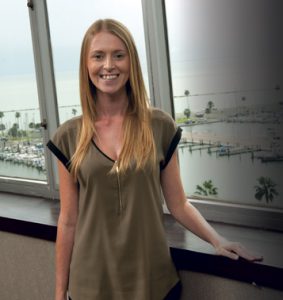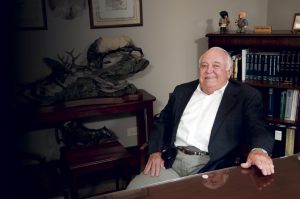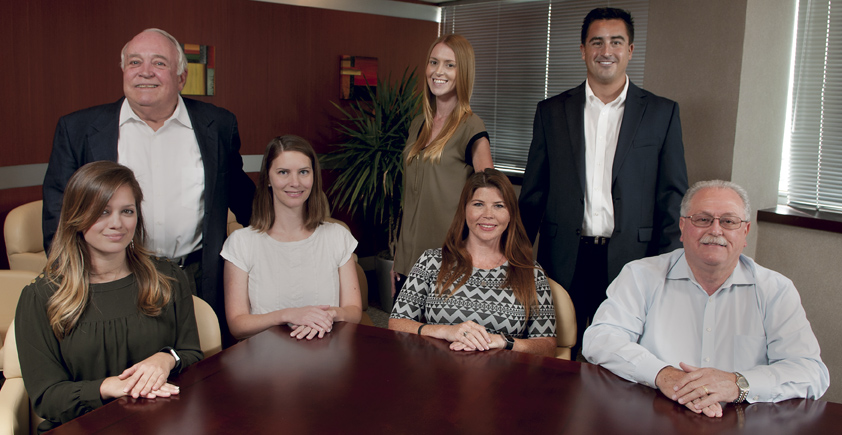P-C agency teams up with benefits expert to meet clients’ needs
Build a base of experience and a strong reputation. Then let youthful energy drive the future. It’s a natural cycle that invigorates agency operations and introduces them to a new generation.
For example, Carlisle Insurance in Corpus Christi, Texas, has spent the last five years creating a solid base of employee benefits business that both supplements and energizes its commercial property/casualty business, says President Tom Carlisle.
“We have been managing benefits for clients for a long time—since we were founded in 1925. Although our operation was mostly property/casualty, employee benefits was an important part of what we did.”

—Sarah Parkey
Account Manager
Carlisle Insurance has always developed trusting relationships with its clients, Carlisle says, and although they may have come to the firm with property/casualty needs, they have often asked the agency to handle their benefits. “It gives them a sense of confidence and security,” he comments.
Employee benefits, Carlisle says, “round out the accounts, creating a greater value for the agency/client relationship. It expands our ability to consult with our clients and provide an advantage to their overall business.”
But benefits services were never more than an ancillary part of the business until about five years ago when Carlisle made a commitment to increase its level of resources and expertise through a joint venture with a local employee benefits expert.
In 2013 Carlisle Insurance joined forces with Bob Corrigan, a veteran employee benefits producer who brought a new series of connections and expertise to the firm. In addition to his experience, Corrigan is a long-time member of United Benefit Advisors (UBA), a national organization of more than 140 employee benefits agents and brokers who share their experience and collaborate on employee benefits management. UBA says its members’ combined client base equals the third largest benefits marketing organization in the country.
Corrigan’s experience with Texas employers and UBA’s national resources make Carlisle Insurance a powerful employee benefits competitor, Carlisle says. “I feel as strongly today about our future in employee benefits as I ever have. With Bob’s experience and UBA’s national resources, I feel we can successfully compete with anybody, including the giant international brokerage companies.”
Benefits now account for 14% to 15% of total agency revenue, and Carlisle expects benefit revenue to double over the next five years to about $3-4 million. Carlisle has three offices in the state, including the Corpus Christi headquarters, Kingsville, and Alice. Leading health insurers in the area include United Healthcare, Humana, BlueCross/BlueShield, Aetna, and CHRISTUS Health Plan, a local provider network.

—Tom Carlisle
President
Carlisle Insurance
Eight of the agency’s 75 employees work in benefits, and Carlisle says the firm is likely to continue to hire benefits specialists as the business expands. The agency offers a wide range of benefits products, including health insurance, dental insurance, disability insurance, and employee-paid voluntary benefits. The agency also provides retirement plan consulting on defined contribution plans.
In addition, the firm provides benefit management services, including benefit communications, open enrollment management, health savings accounts, wellness programs, and regulatory compliance support for FMLA, COBRA, and human resource management.
While the agency’s property/casualty reputation has driven growth in employee benefits among existing clients, the arrival of new benefit clients also has spurred growth in property/casualty business, Carlisle says.
“We have developed a great synergy between our property/casualty and employee benefits business,” he says.
Corrigan is a partner and member of Carlisle-Corrigan Benefits LLC, the joint venture that now leads the agency’s benefits practice. Corrigan, who has been involved in Texas employee benefits sales since 1975, says the field has changed dramatically since he began his career as a young attorney for health insurers and independent agencies.
“Employee benefits used to be a sales and service effort, identifying client needs and then shopping the program to carriers, looking for the best price. But that has changed dramatically. There are fewer health insurers competing for business and much less opportunity to compete on price alone.”
Expertise is usually the deciding factor, as employers seek help in developing a sophisticated health insurance benefit plan that can moderate rising costs, he says. And laws and regulations, including the Affordable Care Act, Family and Medical Leave Act, and other compliance challenges lead employers to seek trusted relationships that can provide guidance as well as access to health plans.
“While Carlisle Insurance had the client base in property/casualty insurance and trusted relationships with employers, they decided to increase the focus in benefits to produce the level of service to which its customers had become accustomed,” Corrigan says. “This allowed them to be able to take advantage of their reputation to drive additional growth in benefits.”
The Carlisle-Corrigan team brought a new and sophisticated approach to employee benefits management and started building a young sales and service staff to drive new business and growth.
The agency uses a proprietary Navigator Discovery process to learn about clients’ needs and analyze the value of their employee benefits budget, identifying opportunities to get maximum value from their benefits plan. The process helps the agency and the employer create a strategic Benefits Blueprint that describes the employer’s approach and the options for reaching its objectives.
Since implementing the new approach in 2013, the joint venture has opened new growth areas for the firm, notably public entities, which often have legislation-driven employee benefit programs, Corrigan says.

—Bob Corrigan
Principal
Carlisle-Corrigan Benefits recently signed two Texas school districts and two municipalities, and Corrigan says the firm has just scratched the surface of the business base in the Rio Grande Valley.
In addition to their experience, the Carlisle-Corrigan team also brought a commitment to building a team for the future. “The key to the future is to find the talent, teach to the youth,” he says.
As part of the benefits expansion, the firm hired two early-career benefits employees, a producer and an account manager, and plans to hire an additional producer and account manager who can work in a team environment and execute new approaches to employee benefits as they become available.
Producer Zach Gingrich and Account Manager Sarah Parkey are good examples, Corrigan says. Gingrich is often the first point of contact for new clients and leads the charge to bring sophistication to Texas employers that need to comply with ACA regulations and also infuse their employee benefits programs with innovation that creates value.
“Every employer is different,” Gingrich explains, “in different industries with different demands. Some employers are fully insured and have been for years, and others are self-insured to give them maximum control.”
Gingrich says it is important to communicate with employers at their level of understanding and within the scope of their needs. “What are they trying to do? Do they want more value from their benefits budget? Do they want to bring more choice to their employees? Is there an opportunity to get creative?”
If employers are only seeking to stabilize their costs, there isn’t much opportunity for plan design options, he says. “Then all we can do it shop the coverage.”
More often, employers are open to changes in their benefits structure, and more are exploring some level of self-funding, he says. “We can help employers survey their employees to find out what they want and what the client can provide that meets employee needs.”
Parkey teams with Gingrich in developing plan designs and marketing coverage to insurers, she says. “I participate from the beginning with quoting, spreadsheets, plan design, and funding requirements.”

—Zach Gingrich
Producer
She agrees that self-funding is becoming more common, and with level-funding plan designs, employers with as few as five employees can realize some advantages.
But Parkey’s work just begins with landing a new client. “Normally we would build an open enrollment system for the employer, communicate the benefit programs to employees in one-to-one or group meetings, and provide ongoing service after enrollment.”
Parkey says she and other account managers respond to a variety of questions from both employers and employees and assist with claims problems and plan design and execution. Parkey, and the other account managers, also provide human resource management support, answering compliance questions and responding to day-to-day employee management questions.
“We get a lot of HR questions and if necessary can connect the employer with HR expertise from the ThinkHR organization. We also advise employers on payroll management and basic human resource management, COBRA, FMLA, and other issues.”
Parkey says account managers “function as though they are part of the client’s company. We are there for them, and they come to us with a broad range of questions and needs.”
Ninety to 130 days in advance of renewal, Parkey says, she and other account managers start gathering updated client information and preparing proposals for benefits and human resource administration so the cycle can begin again.
Now, for two experienced agency executives, the future looks bright and exciting, Carlisle and Corrigan agree, as they pass along what they have learned and the business they have built.
The author
Len Strazewski is a Chicago-based writer, editor and educator specializing in marketing, management and technology topics. In addition to contributing to Rough Notes, he has written on insurance for Business Insurance, Risk & Insurance, the Chicago Tribune and Human Resource Executive, among other publications.






